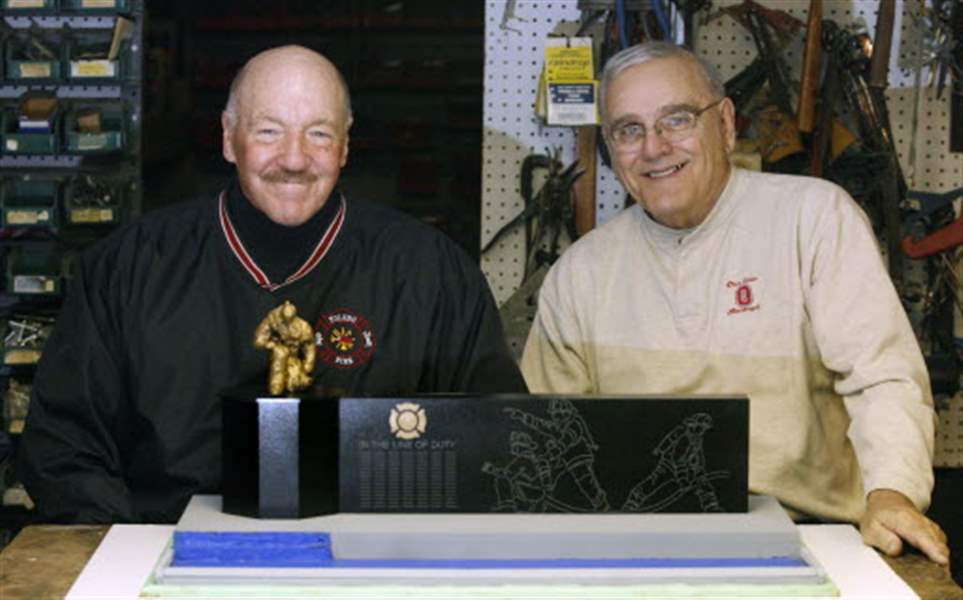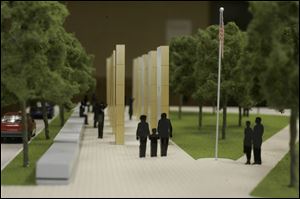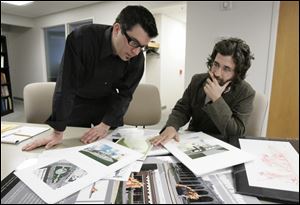
Toledo's firefighter sculpture: still rising from the ashes?
10/10/2010
George Costic, left, and Bill Winkle would like to see a sculpture like the one pictured here in Chub DeWolfe Park.
It would have been the city's most expensive piece of public art, rising from a little-used grassy triangle across from the fire department's headquarters downtown.
The $500,000 sculpture that would honor 45 local men who have lost their lives — and the many more who were injured battling fires and explosions — had the support of the fire chief, firefighters, and the arts community. Momentum built in 2006 and 2007, but seems permanently to have lost steam.
"I don't see it happening in the near future," Fire Chief Michael Wolever said.
"As far as I know it's dead in its tracks," said Robert Schwanzl, retired deputy fire chief and president of the Toledo Fire Museum.
"I'm sorry the whole thing stalled," said Marcia Helman, arts liaison for the city at the time.
Even Mayor Mike Bell who got the ball rolling when he was fire chief, says it's not on the horizon.
How does an idea whose time seems to have come, devolve to an idea whose time has passed?
In a nutshell, leadership changed, the economy fell into crisis, and perhaps, most critically, there was a great divide in aesthetic taste.

A scale-model view of Norman Lee's design that was considered to replace the Last Alarm memorial was presented three years ago.
Honoring heroism
For years, firefighters had talked about building a new sculpture, and it was proposed publicly in 2006 by then Chief Bell at the annual fire memorial ceremony. It would replace Last Alarm, a simple, 20-foot-tall concrete pylon cinched in the middle and nicknamed "The Bone." Made of two concrete and quartz-aggregate halves cemented together, it cost $3,000 when it was built in 1963 out of passion stirred by a horrific 1961 fire that killed four and injured about 15 firefighters. Last Alarm stands in the middle of tiny Chub DeWolfe Park, bounded by Huron, Beech, and Orange streets, where the June memorial service/homecoming is held.
In 2006, the structure was in sorry shape: It was streaked blackish gray, cracked, and the F in TFD was badly faded. Bell said it looked like it was weeping. It had been spruced up five years earlier by the Arts Commission of Greater Toledo (ACGT) at a cost of $7,600.
"I want to develop money to replace or refurbish [the memorial] in a manner that reflects the dignity and heroic actions of the firefighters," Bell said at the time, pledging to meet with representatives of Toledo Firefighters Local 92, the Toledo Fire Museum's board, and retired firefighters.

George Costic, left, and Bill Winkle would like to see a sculpture like the one pictured here in Chub DeWolfe Park.
‘No stones unturned'
His predecessor, former Chief Bill Winkle, was gung-ho. After talking with Bell, Winkle set up committees to handle design, fund-raising, and city-related issues. He and his friend, retired firefighter George Costic, came up with a design featuring bronze firefighters in heroic action above a shallow pool.
Soon, a committee of 30 was formed, including the arts commission. The group liked the idea of realistic figures and a water element. They talked about how to raise the $500,000 Chief Bell suggested, and thought it could be finished in time for the June, 2008 ceremony.
"We'll try everything. We'll leave no stones unturned," Winkle said at the time. In 1967, he was a rookie when he pulled the body of trapped firefighter Chester Rybarczyk from a building.
In retrospect, Winkle said, the suggested half-million-dollar figure for the memorial was unrealistic and worse, a turn-off.
"I think $500,000 is an obscene figure," he said recently.
But in 2006, the idea had legs.
Matt Lewandowski, of Lewandowski Engineers offered to donate civil engineering and surveying services in honor of his mother, Ruth Lewandowski, a nurse who voluntarily cared for some of the men hurt in the 1961 explosion.
The ACGT sent out a nationwide call for artists that drew 71 proposals, and established a design review board that included firefighters as well as people in the arts community. On their own, Winkle and Costic looked for artists who specialized in realistic statues.
Differences arise
Art on city land is managed from inception to maintenance by the ACGT, including the process of selecting the piece of art. This project would turn out to be its most frustrating, said Marc Folk, the commission's executive director.
By April, 2007, the design review board had whittled the 71 proposals to nine. And, Chief Bell, who generated the idea, retired to become the state fire marshal.
"I've wanted to replace it over the last 10 years but the time was not appropriate," he said at the time. "I believe the timing is appropriate in 2007. I believe people understand there might be a better way to honor the heroic actions of firefighters."
His retirement party was a fund-raiser for the new memorial, to be shared with the Boys and Girls Clubs of Toledo.
Bell's choice for a design? Firefighters in action, perhaps with an eternal flame. He's seen beautiful ones in other cities.
"I knew the people in the fire department wanted something like that," Mayor Bell said recently. "If you want the support of the firefighters you have to pick something they want. This whole issue of the memorial is about them."

Marc Folk, executive director of the Arts Commission of Greater Toledo, left, and Adam Russell, the art in public places coordinator, look over the various designs in 2007.
Proposals
In June, 2007, people attending the memorial ceremony strolled into the nearby fire administration building and perused the finalists' drawings. A favorite emerged: a realistic scene with bronze firefighters spraying water on steel flames.
Finalists each received $2,500 from the arts commission to build small models and to come to Toledo and present their ideas to the board. In August, 2007, they made presentations, after which the board voted 6 to 1 for a surprise candidate: a conceptual design featuring five pairs of tall panels by Norman Lee of Willis, Texas. His model looked the best, several board members said, and he explained his ideas convincingly.
"It was clear that the firemen wanted a figurative piece," said Marcia Helman, arts liaison for the city at the time. "I was going to vote for the figurative piece until I saw the presentations."
One finalist had proposed a sculpture made from materials that wouldn't wear well in this climate; the other worked in China and the board thought project management could be difficult from such a distance.
Even Winkle was unhappy with the presentation by the California artist he favored. "I couldn't vote for it."
The board could have voted down all three options, but they didn't.
Norman Lee, who designs exhibits for museums and visitor centers, employed symbols. "It's about creating an environment where you can remember," he said.
His five sets of brass-edged, thick-glass panels washed with a thin veil of water, represented five bells that ring at the funeral of a firefighter. People would walk between the gateway-like panels that would be inscribed with names of firefighters killed on duty. A stone bench etched with a time line and historical photographs would tell Toledo's firefighting story back to 1836 when it was a volunteer group.
"It's another way of getting at the actual story of what firefighters are about," Lee said. He noted the Vietnam Veterans Memorial, which is two black granite walls bearing more than 58,000 names of Americans who died during that war. The design, by 21-year-old Ohioan, Maya Lin, was chosen from 1,421 submissions in 1981. But people insisting on figurative works were so vocal, two have since been added at the site: Three Soldiers and the Vietnam Women's Memorial.
A conceptual sculpture, said Lee, lets people remember in their own way. "Whereas a figurative piece tells people ‘This is the way you should remember firefighters.' You have an artist defining the image of a firefighter for you."
‘Rush process'
One thing that didn't occur before the final selection were public hearings at which firefighters and the general public view proposals and voice their opinions. Folk said his staff tried repeatedly to set up hearings. But Bell had departed and when they called the fire division, they were referred to a variety of people, and couldn't pin down a meeting date. In addition, the ACGT was told to move the project quickly.
"We were informed this was a rush process," Folk said.
In Toledo, public art has come to be paid for by private funds, supplemented by a small portion of tax dollars, he said. It's important for people to buy into their city's artworks for aesthetic reasons as well as to raise the money to build it.
Ideally, artist-finalists present their proposals at a public meeting, solicit feedback, and then return to their studios, revising the sculpture to incorporate those ideas. At a subsequent meeting, they present their adjusted proposal, and the design review board makes its choice.
Plans were to bring Lee back to town so he could listen to firefighters and others and modify his work. It would have been changed anyway because a conservator who reviewed his plan concluded that the water feature would serve as a giant air purifier, sucking in pollen and dirt, and requiring costly maintenance.
Lee wanted such a meeting.
"What I love about public art is the dialogue with the community. You need that. I'll take that feedback and see how it can be incorporated into the design," he said.
But that didn't happen.
The aesthetic breach widened. Winkle, the sole "nay" vote on the board, was bitterly disappointed, feeling as if the project he had envisioned had been snatched away.
"It was a takeover," he said. "We were devastated. We did so much work. ... I didn't like how we were treated by the arts commission. They isolated us and we never all sat down and talked about it [afterward]. Our goal from the start was to show firefighters in action."
Nor would his friend Costic get behind the selection.
"After the Texas sculpture was approved, we thought if we didn't like it, we would have a chance to make our own presentation," Costic said.
They reworked their design and sought bids from other artists and a stone company, figuring they could build it for $320,000. They appealed to then-Mayor Carty Finkbeiner, who listened but told them the arts commission procedure would be followed.
"We are bound by a process," Folk said.
Economic realities
Learning what was afoot, the arts commission reconvened the design review board and the fire department's new chief, Michael Wolever, who asked for additional time to consider the situation.
The ACGT wrote him, offering to donate Last Alarm to the fire museum. They sent information explaining how their procedures work and offered to act as a liaison with artist Lee when the fire department had set up a public hearing.
And in fall, 2007, the economy plummeted.
"I inherited this when I became chief," Chief Wolever said of the memorial.
"When the economy got bad, I had to put an awful lot of energy into focusing on our budget and maintaining service to the public. Running a campaign to build a new monument takes a lot of energy. We prioritized."
Next June, firefighters will memorialize the 50th anniversary of the Trail fire, when a tandem oil truck took a curve too fast and overturned at Collingwood and the Trail. A burning tank generated such thick smoke that firefighters couldn't see the second tank before it exploded.
In May, the 47-year-old, conceptual monument, Last Alarm, was spruced up again, this time with volunteer sweat and donated materials. A new concrete pad was poured, spotlights were rewired, bronze plaques were cleaned. It was painted and flowers were planted.
"When the economy changes, it warrants taking a good, hard look at it," Chief Wolever said.
Contact Tahree Lane at:
tlane@theblade.com
or 419-724-6075.